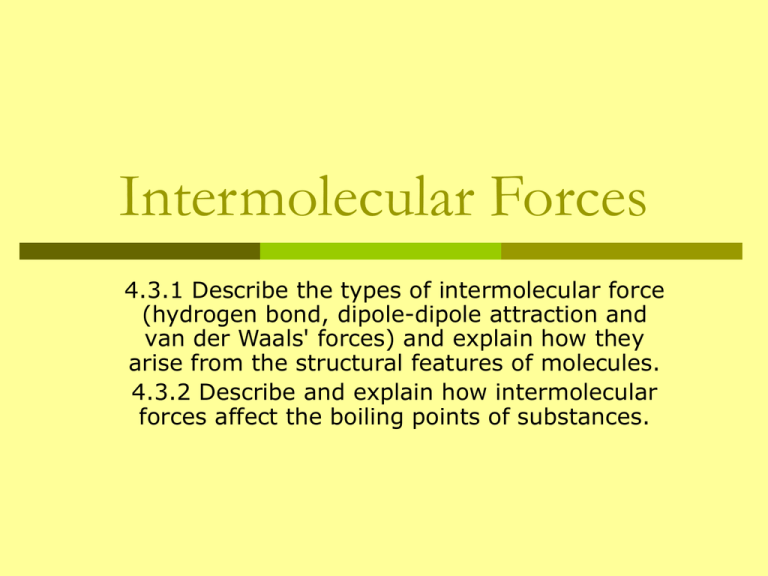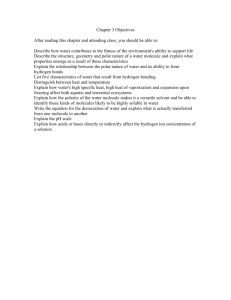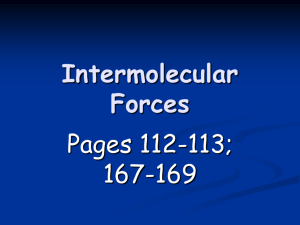Intermolecular Forces
advertisement

Intermolecular Forces 4.3.1 Describe the types of intermolecular force (hydrogen bond, dipole-dipole attraction and van der Waals' forces) and explain how they arise from the structural features of molecules. 4.3.2 Describe and explain how intermolecular forces affect the boiling points of substances. Intramolecular forces Bonding forces that exist within each molecule and influence the chemical properties of the substance Intermolecular Forces Non-bonding force that exist between the molecules and influence the physical properties of the substance. Ex: boiling points are higher for molecules that have stronger intermolecular forces As we discussed with the melting point trends for the halogens in the periodicity unit Dipole-Dipole Forces Dipole = polar molecule Dipoles will change their direction so that their oppositely charged ends are near to one another. The electrostatic attraction between the ends is dipole-dipole force Ion-Dipole Forces The force of attraction between an ion and a polar molecule. The charge of the ion will attract the oppositely partial charge of the dipole. Na+ is a cation, so it attracts the slightly negative end of the water (the oxygen) London (dispersion) Forces weakest intermolecular force between non polar molecules It is a temporary attractive force that results when the electrons in two adjacent atoms occupy positions that make the atoms form temporary dipoles London (dispersion) forces Why does the temporary dipole occur? It results from the random movements of the electrons, especially the valence electrons, that produces and inductive effect on the other molecules close by. The temporary dipole will cause the electrons in another molecule to be repelled (or move away). This will cause an induced dipole (since the electrons moved away, that end of the molecule is more +, while the other end becomes more -) The net result is that there is on average a stronger attractive force between molecules than repulsive. Dipole-Dipole forces The electrostatic attraction between the molecules with permanent dipoles Cause an increase in B.P for those molecules of similar size that are not permanent dipoles. Ex: HCl B.P is 188 K and F2 B.P is 85 K Both have London (dispersion) or van der Waal’s forces between them, but only HCl also has dipole-dipole forces. Hydrogen Bonding It is the attractive force between the hydrogen attached to an electronegative atom of one molecule and an electronegative atom of a different molecule. It is the strongest of the intermolecular forces Hydrogen bonding The molecule involved with hydrogen bonding should have at least one lone pair. More lone pairs= stronger hydrogen bonds. Hydrogen bonding results between the interaction of the lone pair of one atom (small and highly electronegative, like N, O or F) with the hydrogen atom of another molecule Part way between a dipole-dipole bond and a dative covalent bond Formula Intermolecular force Polar or Nonpolar H2O2 BP 431 K (hydrogen bonding) polar C3H8 BP 231 K (van Non-polar der Waals) BP 294 K (no polar hydrogen bond) CH3COH (ethanal) CH3CH2OH (ethanol) BP 352 K (hydrogen bond) polar Boiling points Tetrahedrals with all the same surrounding atoms are NON-POLAR and tend to have low B.P because there is very little intermolecular forces involved. The more lone pairs on the oxygen atom, the more hydrogen bonding, the higher the B.P (ex: H2O) Strength of intermolecular force based on atomic size Melting point is a measure of the difference in strength of the forces between particles between the solid and liquid state. M.P for HF is -118 oC M.P for HCl is -114.2 oC M.P for HBr is -86.8 oC M.P for HI is -50.80 oC The larger the atomic size, the more energy it requires to melt the molecule. The larger the size, the more electrons there are moving randomly around, so the more likely and probably stronger van der Waals forces occuring between each molecule. Readings Pages 450-456 Look over sample problems and be able to interpret graphs. Pay attention to the table 12.2 for a good review of all intra and intermolecular forces Practice problems Page 495 #12.37, 12.38, 12.39, 12.41, 12.52, 12.55 Websites and resources: http://www.ausetute.com.au/intermof.html http://www.chem.purdue.edu/gchelp/liquids/indd ip.html Induced dipoles (ion induced or dipole induced) http://www.mikeblaber.org/oldwine/chm1045/not es/Forces/Intermol/Forces02.htm Intermolecular forces and trends in physical properties review Review intermolecular forces http://en.wikipedia.org/wiki/Hydrogen_bond Hydrogen bonding







